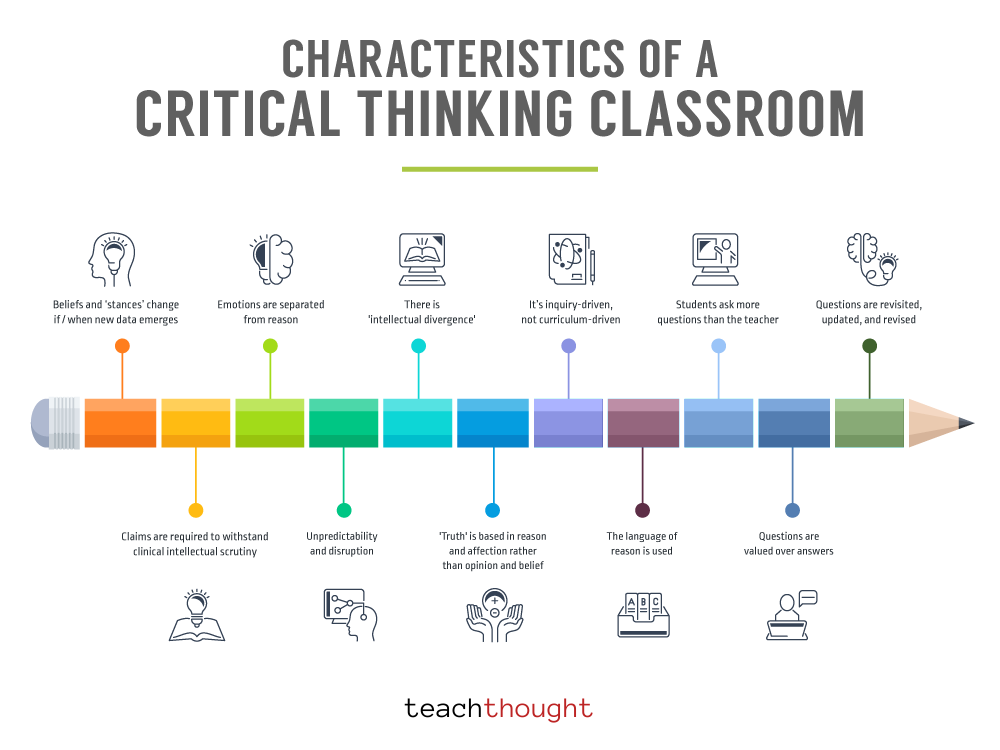What Are The Characteristics Of A Critical Thinking Classroom?
by Terry Heick
The premise here is straightforward: clarifying what critical thinking might ‘look like’ in the classroom. Put another way, what are some indicators that rational thought and careful, critical thinking is not just ‘visible,’ but a part of the culture of a classroom.
In Critical Thinking Is A Mindset, I offered that, “Just as math can be said to be a kind of language and science is a way of thinking, critical thinking (while also being a ‘way’ of thinking) is first a state of mind–a willingness to do so both preceded and proceeded by a motley collection of presuppositions and premises and tendencies and cognitive defaults and even eventually personality traits that manifest when you read a book or have a discussion or skim a news headline or research an idea.”
I also discussed this idea in Teaching Disruptively, when I said, “inquiry-based learning (or critical thinking) that doesn’t just encourage students to ‘discover’ some preselected poet you had in mind, but find their own reasons for reading poetry—then finding their own poets.And perhaps most of all, by creating self-directed learners that can ask the right question at the right time within the right community to affect the kind of change that lasts.”
This concept also surfaced in dozens of other things I’ve written over the years, from Characteristics Of High-Performing Classrooms to Are You Teaching Content Or Are You Teaching Thought? to Correcting The Deficit In Critical Thinking when I wondered if maybe we should, create “learning models that require critical thinking–learning models that cannot function if students (all students) don’t think critically. This would be much like a rowboat where everyone has to row and stops if someone stops rowing; alternatively, break apart the boats completely so every student must row themselves.)someone stops rowing; alternatively, break apart the boats completely so every student must row themselves.”
Which brings us to this post. How do you know if your students are ‘thinking critically’? Of course, the answer depends on a scores and scores of factors, from the grade level and content area you teach to your relationships with students and the nature of your curriculum, units, lessons, and activities. But below are some examples that, if witnessed with any consistency at all, might be a good sign that your students are thinking.
What Are Indicators Of Critical Thinking?
Beliefs and ‘stances’ change if/when new data emerges.
The quality of knowledge and data is more important than an intellectual ‘stance’ of personal opinion.
Claims made–by anyone from the teacher and students to the authors and experts they study–are required to withstand clinical, good faith intellectual scrutiny.
Emotions are separated from reason. That is, they are seen as effects of thoughts rather than equal to thoughts or worthy of similar scrutiny, application, validation, acclaim, etc.
Unpredictability and ‘disruption’ (of ideas, some planning, assessment forms, traditional thinking patterns, etc.)
‘Intellectual divergence’ where thinkers seek to be in the company of evidence, truth, data, and perspective and are ‘diverge’ from one another/you/authors, etc. not emotionally (though that’s okay at times) but conceptually and intellectually.
‘Truth’ is based in reason and affection rather than opinion and belief.
Learning is inquiry-driven (through curiosity and knowledge demands), not curriculum-driven.
Students ask–then improve–questions to drive lessons, projects, discussions, etc.
The language of reason is used: words and phrases that clarify and endorse uncertainty and the need for more knowledge/data, sentence stems that clarifying positions or seek to clarify others, neutral transitional statements, etc.
Literacy in fallacies and biases. That is, heuristics, cognitive biases, and logical fallacies are discussed frequently and without ‘great prompting’ and effort.
The legacy of ideas and their origin/momentum/endorsement/change over time in response to data and new thinking, etc.
Humility. (This is at the core of rational, critical thought. Humility says, ‘I’m not sure’ or ‘I don’t know enough to have an informed opinion’ or ‘Let’s gain knowledge so that we can reduce uncertainty.’)
Students ask more questions than the teacher.
Questions are valued over answers.
Questions are revisited, updated, and revised.

